#audubon center
Explore tagged Tumblr posts
Text

Broad-tailed hummingbird (probably) visiting a garden fountain at the Randall Davey Audubon Center in Santa Fe, New Mexico.
107 notes
·
View notes
Video
Western Hognose Snake by Sheridan Via Flickr: Taken at Mitchell Lake Audubon Center, Oct. 25, 2008. This was a captive snake. I love the way the tongue turned out.
168 notes
·
View notes
Text



Recent birds: Broad-billed hummingbird / colibrí pico ancho (Cynanthus latirostris) at the Paton Center for Hummingbirds in Patagonia, Arizona.
The top and center photos are of mature female and male birds. In the bottom photo a patchy immature male broad-bill, whose colors are just beginning to come in, looks across the feeder at a splendid mature male. Someday, little bird!
#photographers on tumblr#broad-billed hummingbird#Cynanthus latirostris#Paton Center for Hummingbirds#Tucson Audubon#Patagonia#Santa Cruz County#Arizona
114 notes
·
View notes
Text
Loki the Crow painting at the Audubon Nature Center.

Loki the Crow painting at the Audubon Nature Center.
#crow#painting#avian#crow art#loki#corvus#fuckary#fuckarylee#poe#poetry#fucking perfect#glamboyl#Audubon Nature Center#audubon
1K notes
·
View notes
Text
youtube
Meet Teresa Edwards, the Manager of Student Services at Philadelphia Technician Training Institute. In this Instructor Spotlight, Teresa shares valuable insights into the admissions process, available grants, and what students can expect from the programs at PTTI.
#industrial technician in philadelphia#trade Programs in Haddonfield#NJ#technician training institute in Darby PA#best trade schools in philadelphia#trade school in south philadelphia west#types of skilled trades in philadelphia#vocational training in philadelphia#technician training institute in Audubon NJ#philadelphia training center#technician training institute in Haddonfield NJ#Youtube
0 notes
Text









A little hike at another Audubon facility
1 note
·
View note
Text
"Chicago’s 82-story Aqua Tower appears to flutter with the wind. Its unusual, undulating facade has made it one of the most unique features of Chicago’s skyline, distinct from the many right-angled glass towers that surround it.
In designing it, the architect Jeanne Gang thought not only about how humans would see it, dancing against the sky, but also how it would look to the birds who fly past. The irregularity of the building’s face allows birds to see it more clearly and avoid fatal collisions. “It’s kind of designed to work for both humans and birds,” she said.
As many as 1 billion birds in the US die in building collisions each year. And Chicago, which sits along the Mississippi Flyway, one of the four major north-south migration routes, is among the riskiest places for birds. This year, at least 1,000 birds died in one day from colliding with a single glass-covered building. In New York, which lies along the Atlantic Flyway, hundreds of species traverse the skyline and tens of thousands die each year.
As awareness grows of the dangers posed by glistening towers and bright lights, architects are starting to reimagine city skylines to design buildings that are both aesthetically daring and bird-safe.

Pictured: Chicago's Aqua Tower was designed with birds in mind.
Some are experimenting with new types of patterned or coated glass that birds can see. Others are rethinking glass towers entirely, experimenting with exteriors that use wood, concrete or steel rods. Blurring lines between the indoors and outdoors, some architects are creating green roofs and facades, inviting birds to nest within the building.
“Many people think about bird-friendly design as yet another limitation on buildings, yet another requirement,” said Dan Piselli, director of sustainability at the New York-based architecture firm FXCollaborative. “But there are so many design-forward buildings that perfectly exemplify that this doesn’t have to limit your design, your freedom.”
How modern buildings put birds in danger
For Deborah Laurel, principal in the firm Prendergast Laurel Architects, the realization came a couple of decades ago. She was up for an award for her firm’s renovation of the Staten Island Children’s Museum when the museum’s director mentioned to her that a number of birds had been crashing into the new addition. “I was horrified,” she said.
She embarked on a frenzy of research to learn more about bird collisions. After several years of investigation, she found there was little in the way of practical tips for architects, and she teamed up with the conservation group NYC Audubon, to develop a bird-safe building guide.
The issue, she discovered, was that technological and architectural advancements over the last half-century had in some ways transformed New York City – and most other US skylines and suburbs – into death traps for birds...
At certain times of day, tall glass towers almost blend into the sky. At other times, windows appear so pristinely clear that they are imperceptible to birds, who might try to fly though them. During the day, trees and greenery reflected on shiny building facades can trick birds, whereas at night, brightly lit buildings can confuse and bewilder them...

Pictured: A green roof on the Javits Convention Center serves as a sanctuary for birds.
The changes that could save avian lives
About a decade ago, Piselli’s firm worked on a half-billion-dollar renovation of New York’s Jacob K Javits Convention Center, a gleaming glass-clad space frame structure that was killing 4,000-5,000 birds a year. “The building was this black Death Star in the urban landscape,” Piselli said.
To make it more bird friendly, FXCollaborative (which was then called FXFowle) reduced the amount of glass and replaced the rest of it with fritted glass, which has a ceramic pattern baked into it. Tiny, textured dots on the glass are barely perceptible to people – but birds can see them. The fritted glass can also help reduce heat from the sun, keeping the building cooler and lowering air conditioning costs. “This became kind of the poster child for bird-friendly design in the last decade,” Piselli said.
The renovation also included a green roof, monitored by the NYC Audubon. The roof now serves as a sanctuary for several species of birds, including a colony of herring gulls. Living roofs have since become popular in New York and other major cities, in an inversion of the decades-long practice of fortifying buildings with anti-bird spikes. In the Netherlands, the facade of the World Wildlife Fund headquarters, a futuristic structure that looks like an undulating blob of mercury, contains nest boxes and spaces for birds and bats to live.
The use of fritted glass has also become more common as a way to save the birds and energy.
Earlier this year, Azadeh Omidfar Sawyer, an assistant professor in building technology in the Carnegie Mellon School of Architecture, working with student researchers, used open-source software to help designers create bespoke, bird-friendly glass patterns. A book of 50 patterns that Sawyer published recently includes intricate geometric lattices and abstract arrays of lines and blobs. “Any architect can pick up this book and choose a pattern they like, or they can customize it,” she said.
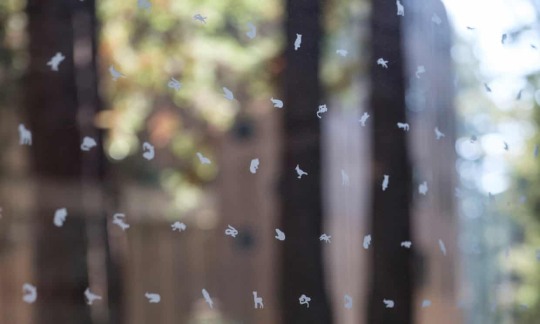
Pictured: The fritted glass used in Studio Gang’s expansion of Kresge College at the University of California, Santa Cruz, depicts the animals in the local ecosystem.
Builders have also been experimenting with UV-printed patterns, which are invisible to humans but perceptible to most birds. At night, conservationists and architects are encouraging buildings turn off lights, especially during migration season, when the bright glow of a city skyline can disorient birds.
And architects are increasingly integrating screens or grates that provide shade as well as visibility for birds. The 52-floor New York Times building, for example, uses fritted glass clad with ceramic rods. The spacing between the rods increases toward the top of the building, to give the impression that the building is dissolving into the sky.
Gang’s work has incorporated structures that can also serve as blinds for birders, or perches from which to observe nature. A theater she designed in Glencoe, Illinois, for example, is surrounded by a walking path made of a wood lattice, where visitors can feel like they’re up in the canopy of trees.
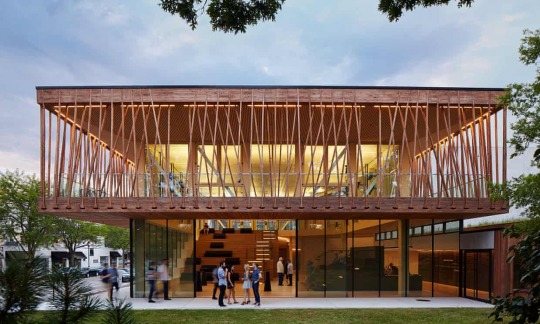
Pictured: The Writers Theatre, designed by Studio Gang, includes a walking path encased in wood lattice.
Rejecting the idea of the iridescent, entirely mirrored-glass building, “where you can’t tell the difference between the habitat and the sky”, Gang aims for the opposite. “I always tried to make the buildings more visible with light and shadow and geometry, to have more of a solid presence,” she said.
Gang has been experimenting with adding bird feeders around her own home in an effort to reduce collisions with windows, and she encourages other homeowners to do the same.
“I’ve found that birds slow down and stop at feeders instead of trying to fly through the glass,” she said.
While high-rise buildings and massive urban projects receive the most attention, homes and low-rise buildings account for most bird collision deaths. “The huge challenge is that glass is everywhere.” said Christine Sheppard, who directs the glass collisions program at the American Bird Conservancy (ABC). “It’s hard to know what I know and not cringe when I look at it.”
Tips for improving your own home include using stained glass or patterned decals that can help birds see a window, she said. ABC has compiled a list of window treatments and materials, ranked by how bird-safe they are.
Whether they’re large or small, the challenge of designing buildings that are safe for birds can be “liberating”, said Gang, who has become an avid birdwatcher and now carries a pair of binoculars on her morning jogs. “It gives you another dimension to try to imagine.”"
-via The Guardian, December 27, 2023
#conservation#birds#avian#ornithology#new york city#chicago#united states#architecture#green architecture#conservation biology#construction#sustainability#glass#glass windows#skyscraper#cityscape#buildings#bird conservation#birdwatching#good news#hope#“hey mc why is this post so in depth and full of pics compared to what you usually post” you ask#great question#the answer is bc I like architecture a lot#...well I like the kinds of architecture I like a lot lol#bauhaus can fight me tbh#but sustainable architecture is awesome#also this article actually came with a bunch of pics#which yknow most of them don't#cw animal death
1K notes
·
View notes
Text

So I went on a phenology walk at Ozark Audubon today. We were mainly looking for any flowers that might have survived the freeze a few days ago, but we found some other neat stuff, too. This was one of the coolest! Look closely at the end of the branch--you can see where it has been neatly carved away, and then snapped in the center after the branch died.
That's the work of the female twig girdler (Oncideres cingulata), a species of longhorn beetle found in the east and midwest United States. She girdles the branch of a hardwood tree, lays her eggs in the branch, and then after it falls the eggs hatch and the larvae feed on the dead wood.
#insects#beetles#invertebrates#trees#native species#Missouri#Ozarks#nature#wildlife#animals#ecology#environment#science#scicomm#biology
364 notes
·
View notes
Text
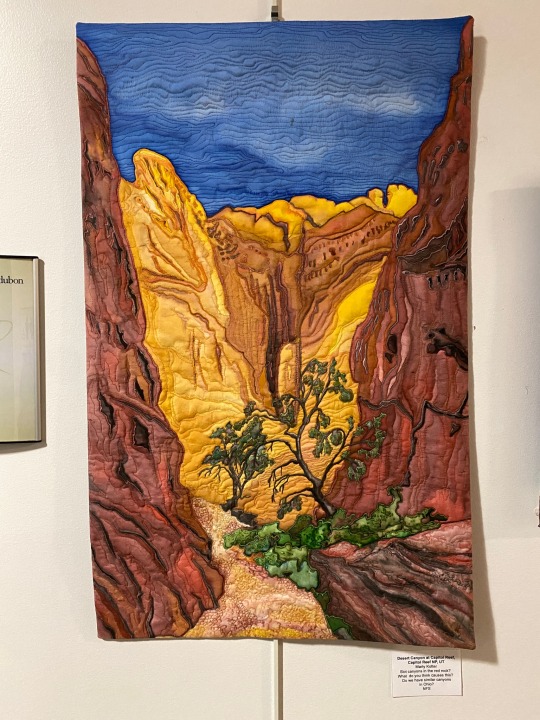
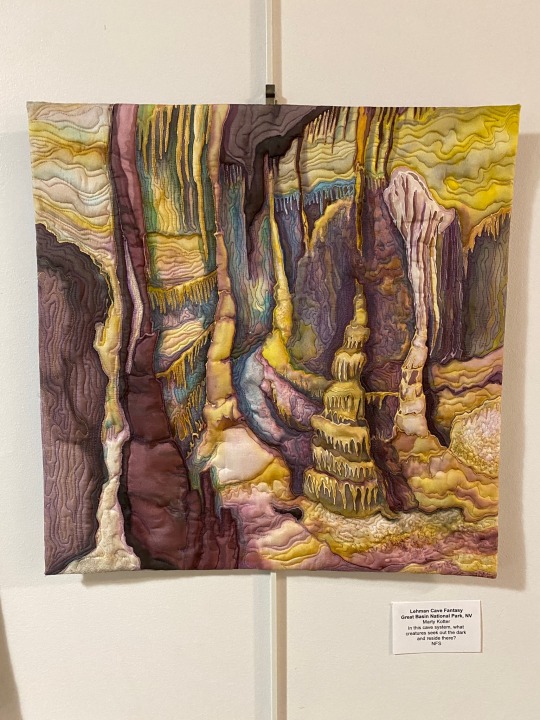
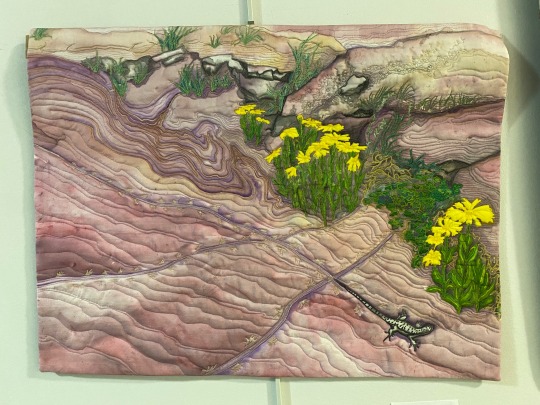
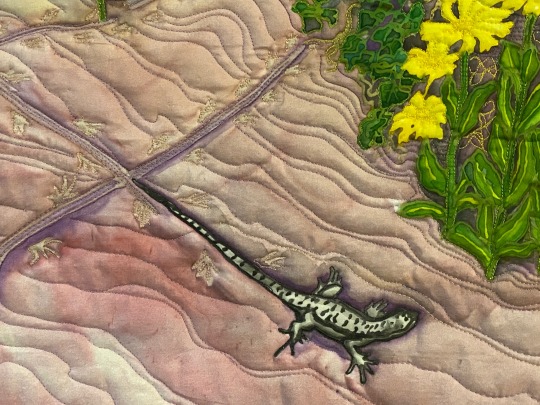



June 11, 2023
Quilting by Marty Kotter
Grange Insurance Audubon Center - Columbus OH
739 notes
·
View notes
Note
Any tips for getting better at birding? I've been doing it for about two years and with the needs update emails I get, I'm starting to feel like I'm just really terrible at it.
Like 'That place you went to see ducks in the morning because that's when the local audubon said to go, they were all there in the afternoon, that place you went after work, the ducks were there three hours later and an osprey too.'
No amount of reminding myself even though some treat it like one, it's not actually a contest, or that you're allowed to suck at your hobbies and can still enjoy them is helping.

Scarlet Tanager (USFWS)
I'm going to hand this over to my BF, Paxon, since he has worked as a birding guide, and has been birding far longer than me...

Baltimore Oriole (USFWS)
Paxon: How to get better at birdwatching...
It's really as simple as, the more you do it, the better you get at it. You just have to go birdwatching A LOT, to get good at it. This is also something you need to do with more experienced people. It is probably not something you're going to get good at, if you do it alone.
Here are some tips:
Go on birdwatching tours with experienced guides. You can find local tours through your local nature centers and Audubon Societies. This is the most important tip for getting better, tbh.
Make sure you have decent binoculars. I understand that you may not want to spend $2000 for a pair of Leicas, at this point, but cheap binoculars will only lead to heart ache. Try to at least buy a decent pair or $200-$400 binocs, or you won't really be able to see the birds well enough. Celestron, Eagle Optics, and Vortex have some good binocs.
Make sure to get some good field guides and bird apps. We can send you a list of recommendations, if you like, DM us.
Educated yourself as much as possible. Watch tutorials on youtube (ie: Identifying Spring Warblers). Go to classes and presentations at Audubon and Nature Centers. Buy some "birdwatching tips" and "identifying hawks" books.

Prothonotary Warbler (USFWS)
127 notes
·
View notes
Text
Today is #AudubonDay, commemorating pioneering naturalist and artist John James Audubon who was born #OTD (26 April 1785 - 27 January 1851). I put together this overview of the 5 now extinct and 3 other possibly extinct birds whose images are recorded in The Birds of America for the blog:


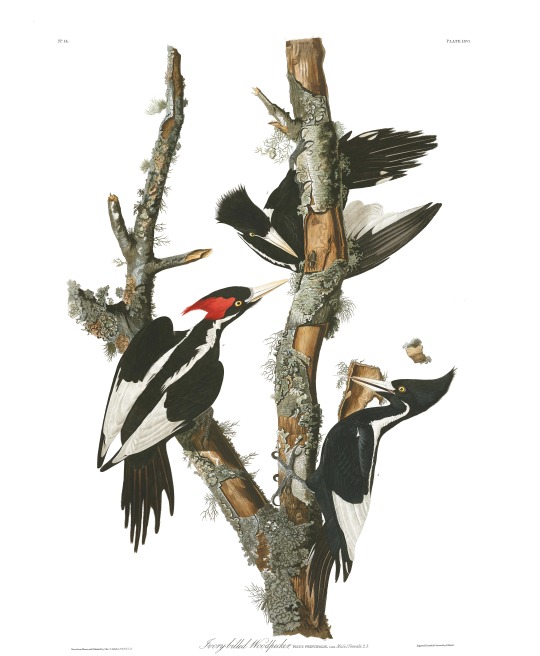


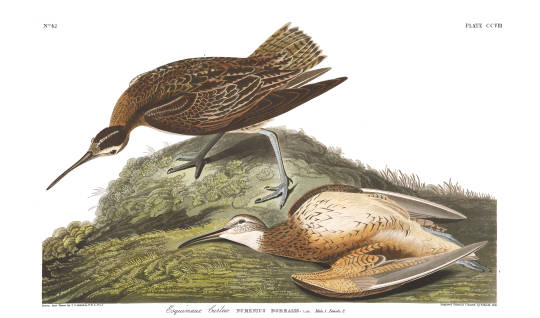


Plate 26: Carolina Parrot, 1827 (Carolina Parakeet, Conuropsis carolinensis) Plate 62: Passenger Pigeon, 1829 (Passenger Pigeon, Ectopistes migratorius) Plate 66: Ivory-billed Woodpecker, 1829 (Ivory-billed Woodpecker, Campephilus principalis) Plate: 185: Bachman’s Warbler, 1834 Bachman’s Warbler, Vermivora bachmanii) Plate 186: Pinnated Grous, 1834 (Heath Hen, Tympanuchus cupido cupido) Plate 208: Esquimaux Curlew, 1834 (Eskimo Curlew, Numenius borealis) Plate 332: Pied Duck, 1836 (Labrador Duck, Camptorhynchus labradorius) Plate 341: Great Auk, 1836 (Great Auk, Pinguinus impennis)
All plate images courtesy of the John James Audubon Center at Mill Grove, Montgomery County Audubon Collection, and Zebra Publishing. The entire digitized collection is available for viewing and downloading here.
#Audubon Day#Audubon#John James Audubon#bird#birds#birding#ornithology#ornihological illustration#scientific illustration#natural history art#sciart#19th century art#American art#lithograph#extinction#extinct birds#conservation biology#blog post#OTD#birthday post#animals in art
351 notes
·
View notes
Text
just wanna add my two cents, I'm a member of both the Cornell Lab of Ornithology and the National Audubon Society and I cannot recommend them enough as far as organizations to be a part of. if you hit a certain donation requirement (I believe for both organizations it's their lowest tier available), you'll get a subscription to their magazine publications for a year, which are packed to the brim with eye-opening scientific research and data about the state of the climate. yes, these publications center around birds, but it's useful info to stay informed regarding the environment anyway.
I also recommend supporting the National Wildlife Federation or even just signing up for their emails. they send lots of emails regarding actions you can take to write to your representatives about stances on important climate issues, and all the letters are pre-written so you just have to enter your personal information and send them off. it's a great first step to being politically involved. idk, just something to think about.
13 notes
·
View notes
Text

Recent birds: Violet-crowned hummingbird / colibrí corona violeta (Leucolia violiceps) at the Paton Center for Hummingbirds in Patagonia, Arizona.
#photographers on tumblr#violet-crowned hummingbird#Tucson Audubon#Patagonia#Santa Cruz County#Arizona#Lucolia violiceps#Paton Center for Hummingbirds
122 notes
·
View notes
Text
BOTD: Fork-tailed Storm-Petrel

Photo: Eric Ellingson
"A small, silvery seabird of cold waters off the Pacific Coast, most common off southern Alaska. Flutters low over the waves offshore, sometimes in flocks. Its center of distribution is much farther north than those of other storm-petrels in Pacific; it is able to fly well even in serious winter storms, zigzagging through wave troughs."
- Audubon Field Guide
#birds#fork tailed storm petrel#birds of north america#north american birds#petrels#storm petrels#seabirds#sea birds#birds of the us#birds of canada#birding#bird watching#birdblr#birblr#bird of the day#Hydrobates furcatus
34 notes
·
View notes
Text
How To Get The Most out Of A Skilled Trades Training Program?
Skilled Trades training is vital for better understanding of trade jobs. Read more to learn how to get the most out of a trade program.
#skilled trade jobs in philadelphia#industrial technician in philadelphia#trade Programs in Haddonfield#NJ#technician training institute in Darby#PA#best trade schools in philadelphia#trade school in south philadelphia west#types of skilled trades in philadelphia#vocational training in philadelphia#technician training institute in Audubon#philadelphia training center
0 notes
Photo

Have you ever seen anything as Goth as a crow painting a picture? (This is Loki the Crow painting at the Audubon Nature Center.
https://thebibliomancer.tumblr.com/post/706443953251188736
248 notes
·
View notes
